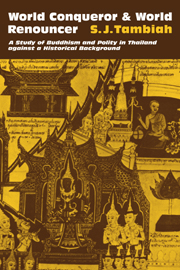 World Conqueror and World Renouncer
World Conqueror and World Renouncer Published online by Cambridge University Press: 10 November 2010
Scholars have found themselves at variance in their interpretations of the nature of the Buddhist content of Asokan political and religious policy. On the one hand there is the highly idealized and embellished partisan view stated in the Buddhist chronicles and legends that Asoka was the great dhammika dhammaraja, the builder of grand architectural monuments all over India, the great patron of Buddhism, its defender as, for instance, described in the story of the Third Council and the expulsion of 80,000 heretics under the direction of the great monk-elder, Mogaliputta Tissa, and its propagator, as eulogized in the legend of the nine missions sent to spread the message of Buddhism, six within his vast kingdom and three to Ceylon, the “Yona” country (perhaps Bactria) and Suvarna-bhumi (in popular tradition located in the Burma-Siam region).
Certain scholars (e.g., Dutt 1962 and Thapar 1961) have insisted that the Buddhist protagonist “mythologization” of Asoka as the Buddhist emperor, based on the legends and accounts fathered by the monks (as, for example, the Sinhalese chronicles), should be kept separate from the historian's assessment of the evidence based on the inscriptions and archaeological finds.
Unfortunately, the evidence on which to base an objective history of the Asokan era is none too plentiful. The position that we take is twofold:
1. Insofar as the Theravada literature, especially the chronicles and legends, have provided the model of kingship for the kings of Theravada polities, a model both generating and legitimating political action, such a model becomes a part of history and must be seriously taken into account.
To save this book to your Kindle, first ensure [email protected] is added to your Approved Personal Document E-mail List under your Personal Document Settings on the Manage Your Content and Devices page of your Amazon account. Then enter the ‘name’ part of your Kindle email address below. Find out more about saving to your Kindle.
Note you can select to save to either the @free.kindle.com or @kindle.com variations. ‘@free.kindle.com’ emails are free but can only be saved to your device when it is connected to wi-fi. ‘@kindle.com’ emails can be delivered even when you are not connected to wi-fi, but note that service fees apply.
Find out more about the Kindle Personal Document Service.
To save content items to your account, please confirm that you agree to abide by our usage policies. If this is the first time you use this feature, you will be asked to authorise Cambridge Core to connect with your account. Find out more about saving content to Dropbox.
To save content items to your account, please confirm that you agree to abide by our usage policies. If this is the first time you use this feature, you will be asked to authorise Cambridge Core to connect with your account. Find out more about saving content to Google Drive.